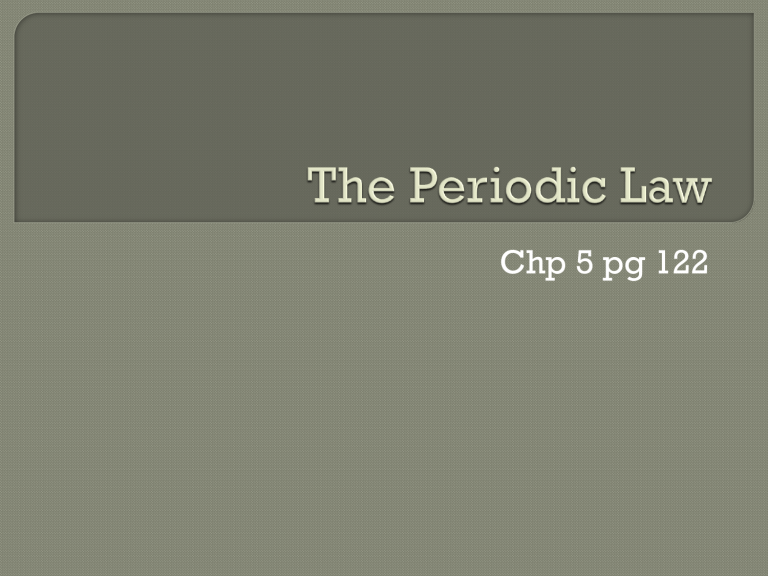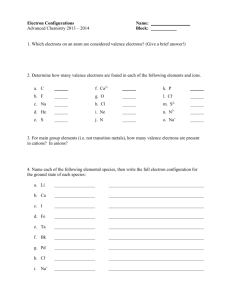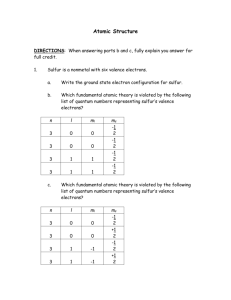File

Chp 5 pg 122
A.
1.
History of the Periodic Table
Mendeleev a.
Wanted to organize elements by properties b.
Left empty spaces for elements that hadn’t been discovered c.
Elements were discovered and fit in his spaces
2. Moseley a.
Arranged elements by number of protons b.
Worked with what
Mendeleev said
3. Modern Periodic Table a. Changed many times before what we have now b. Periodic table – arrangement of elements in order of their atomic #s so elements w/same properties are in the same column c. Noble gases
1) Took long time to discover
2) Don’t react
d. Lanthanides – atomic numbers 58 – 71 e. Actinides – atomic numbers 90 – 103 f. Lanth and act, belong in periods 6 &7 in between families 3 and 4
1) Period – horizontal row
2) Family (groups) a) Columns b) Same number of val. electrons c) Causes same properties
1.
2.
a.
Electrons of highest energy level give atom’s properties (valence electrons)
Periods and Blocks of Periodic Table b.
Period tells what energy level
Families determine # of valence electrons
c. Blocks – tells which sublevel is filled
1) s-block = groups 1 and 2
2) p-block = groups 13-18 (not helium)
3) d-block = group 3-12
4) f-block = lanthanides, actinides
3. s-block elements a. Chemically reactive metals b. Family 1 = more reactive than 2 c. Alkali metals
1) Family 1
2) One valence electron
3) Lose electron easily
4) Silvery appearance
5) Very soft – cut with knife
6) Not found as free elements
7) More reactive at bottom of table
d. Alkaline-earth metals
1) Group 2
2) 2 valence electrons
3) Harder, denser, and stronger than group 1
4) Higher melting points
5) Not free elements
6) Calcium: bones, limestone, marble
MacGyver – Na bomb http://www.youtube.com/watch?v=Q0ASFXacVK0
4. Hydrogen and Helium a. Hydrogen
1) Doesn’t have same properties as family 1
2) Used in ammonia (NH3) and fertilizers b. Helium
1) Not reactive
2) Only 2 electrons
Used H not He
5. d-block elements (Groups 3-12) a. Transition metals b. Good conductors – heat and electricity c. High luster d. Less reactive than families 1 & 2 e. Can exist as free elements
Mercury: http://www.youtube.com/watch?v=gjR6ZJzXdIs&feature=relmfu
6. p-block elements a. Valence electrons = family number minus 10 b. Has metalloids and nonmetals c. Halogens
1) Most reactive nonmetals
2) Family 17 d. Metalloids (semiconductor)
1) Both sides of zigzag
2) Brittle solids
3) Characteristics of metals and nonmetals
e. Noble gases
1) Group 18
2) Full outer shell (8 val. electrons)
3) Argon first discovered a) William Ramsey b) From Greek word argos meaning “lazy” or “inactive”
7. f-block elements a. Lanthanides
1) Shiny
2) Used in color TV and monitors b. Actinides
1) Radioactive
2) 94 – 103 are only in labs
1.
2.
Mixture of 2 or more elements of which at least one is a metal
Examples a.
Sterling silver
1) Silver and copper
2) Resists corrosion and stronger than silver
b. Steel
1) Mix of iron, carbon, and sometimes manganese and nickel
2) Very strong c. Stainless steel
1) Steel and chromium
2) Resists rust
STERLING SILVER STAINLESS STEEL
1.
a.
Atomic Radii
½ the distance between 2 nuclei of identical atoms bonded together
b. Gets smaller going to the right
1) More electrons and protons
2) Pull things together more c. Get larger going down a group
2. Ionization Energy a. Electrons can be removed w/enough energy b. Ion – atom with a charge c. Ionization – anything that causes the formation of ions d. Ionization energy – energy needed to remove electrons e. Low IE = high reactivity f. 2 nd electron takes more energy to remove than 1 st ; 3 rd more than 2 nd
3. Electron Affinity a. Energy change that occurs when an electron is added to a neutral atom b. Atom will be unstable and lose the electron c. Halogens gain them rapidly d. Decreases down a group e. Increases going left to right across period
4. Ionic Radii a. Cation – positive ion
1) Loss of 1 or more electrons
2) Decrease in atomic radius; smaller electron cloud
3) Typically metals b. Anion – negative ion
1) Adding 1 or more electrons
2) Increase in atomic radius
3) Typically nonmetals
5. Valence Electrons (150) a. Electrons that are gained, lost, or shared are valence electrons b. Outermost electrons c. Found in completely filled orbits d. Determining number of valence electrons
1) Group 1 & 2 – have 1 & 2 valence electron
2) Group 13-18 – subtract 10 from group #
6. Electronegativity a. How well an atom in a chemical compound attracts electrons b. Makes a higher concentration of electrons c. Decreases down a group d. Increases left to right across period




